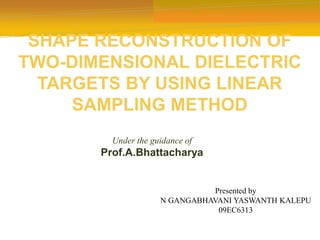This document describes using the linear sampling method to reconstruct the shape of two-dimensional dielectric targets from scattered field measurements. The linear sampling method solves an integral equation to determine if a test point is inside the target support. Regularization is used to address ill-posedness. Numerical results show the reconstructed shape varies slightly with frequency and accuracy improves with more transmitters/receivers. The method provides fast reconstruction of target support but not material properties. Future work includes extending to 3D imaging and using linear sampling method results to initialize other reconstruction algorithms.







![07/05/2011 8
is the region under test, is the (possibly not connected) support of the
dielectric scatterers and is the contrast .
Measurement probes and primary sources lie on a curve located in the scatterers far-
zone (i.e., at a distance R >2d2/λ ,d being the size of and λ the wavelength), so that
incident fields can be well approximated by plane waves
let k be the background wave number and the scattered far-field pattern as
measured on in the direction , when a unit amplitude plane wave impinges from
the direction . For a generic point , the LSM consists in solving the “far-field”
integral equation in the unknown
Wherein the right-hand side is the far-field radiated on Г by an
elementary source located in .
[4]](https://image.slidesharecdn.com/c2b35c78-ec85-48f2-86a0-1803dc040f7c-150829044047-lva1-app6892/85/Final-Seminar-8-320.jpg)
![By introducing the operator and the function ,
can be synthetically rewritten as
The generalized solution of above equation is such that its
( i.e , the “energy”) becomes unbounded when rp does not belong to
the support of the scatterer .
plays the role of supporting function
[4]
[4]](https://image.slidesharecdn.com/c2b35c78-ec85-48f2-86a0-1803dc040f7c-150829044047-lva1-app6892/85/Final-Seminar-9-320.jpg)


![07/05/2011 12
Forward Scattering Problem
The electromagnetic field generated in an unbounded region (free-
space radiation) by the impressed source J0 satisfying wave equations ,
along with the Silver-Muller radiation conditions, can be expressed in
integral form as
Where is the free-space Green dyadic tensor given by (Tai
1971) [3]](https://image.slidesharecdn.com/c2b35c78-ec85-48f2-86a0-1803dc040f7c-150829044047-lva1-app6892/85/Final-Seminar-12-320.jpg)




![07/05/2011 17
Moreover, since the following relation holds (Balanis 1989)[14]](https://image.slidesharecdn.com/c2b35c78-ec85-48f2-86a0-1803dc040f7c-150829044047-lva1-app6892/85/Final-Seminar-17-320.jpg)
![07/05/2011 18
Discretization of the continuous model
[9]](https://image.slidesharecdn.com/c2b35c78-ec85-48f2-86a0-1803dc040f7c-150829044047-lva1-app6892/85/Final-Seminar-18-320.jpg)

![RESULTS
We have considered the “Marseille” experimental data-set[6]. This data-set is
related to an aspect-limited configuration in which the primary source is
moved along a circumference with a 10o angular step (Nv=36 ), and for each
illumination, the measurement probe is moved with an angular step of 5o along
a 240o arc which excludes the 120o angular sector centered around the
incidence direction.
07/05/2011 20
A bistatic measurement system is used to measure the EM field](https://image.slidesharecdn.com/c2b35c78-ec85-48f2-86a0-1803dc040f7c-150829044047-lva1-app6892/85/Final-Seminar-20-320.jpg)
























![07/05/2011 45
Infinitely long filament of constant ac-current along z axis, as shown in Figure.
The field will be TM to z, expressible in terms of an A having only a z
component Ψ. From Symmetry, Ψ should be independent of and z. To
represent outward-traveling waves, we choose[4]](https://image.slidesharecdn.com/c2b35c78-ec85-48f2-86a0-1803dc040f7c-150829044047-lva1-app6892/85/Final-Seminar-45-320.jpg)
